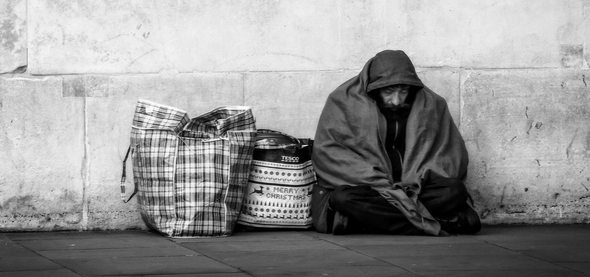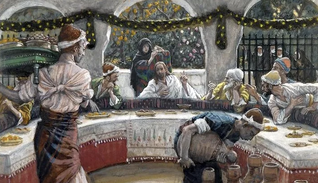 While the Pharisees and scribes grumbled that Jesus was receiving tax collectors and the marginal, the uneducated, outcasts living in “the streets and lanes of the city,” and “the poor and crippled and blind and lame” (14:21), eating with them, Jesus asked them a question:
The question sets up an expected answer: “No, no-one would do that!” Such a decision puts the 99 at risk (stop thinking Jesus means for us to assume the shepherd left the 99 well attended—that would spoil the story all together—not sure we are to assume nor fill in the blanks). Simply we have, you see,“Lost sheep happen.” Still, the angle Jesus shoots for is dangerously shocking: this rather well-off Shepherd (having 100 sheep would have indicated he leaned toward being a more wealthy Shepherd) goes and seeks his lost sheep, carries it home, and everyone rejoices. This is the counter to the grumbling of the Pharisees and scribes that Jesus was welcoming and eating with the likes of those strays from Galilee and the marginal he'd been picking up while on his way to Jerusalem. While it is good to see the Shepherd as a picture of Jesus, this leaves the listener/reader with nothing to do but contemplate how much Jesus loves him. A good thing and important, sure, but that’s not Luke’s point. This is a counter to the Pharisees and scribes, which should indicate what we have here is a counter-intuitive correction to the church’s proclivity toward doing exactly what the Pharisees and scribes were doing: neglecting the poor and marginal and socially unacceptable, whether it be to affirm the cultural and socially tiered-hierarchies (both church and outside the church) and/or to not be so unwelcoming of such among them as a church and/or creating and maintaining institutional systems that affirms and sustains the haves/have-nots at church (cf. the problem in James). This is exactly what the previous Banquet parable was about in Luke 14. Additionally, the interlude on discipleship just prior (14:25-33) instructs us that discipleship is following Jesus, and thus we have our marching orders here in this (and the next two) parables of Luke 15.
0 Comments
 “One Sabbath, when he went to dine at the house of a ruler of the Pharisees, they were watching him carefully. And behold, there was a man before him who had dropsy. And Jesus responded to the lawyers and Pharisees, saying, “Is it lawful to heal on the Sabbath, or not?” But they remained silent. Then he took him and healed him and sent him away” (Luke 14:1-4). I take it that Jesus could have engaged from a range of folks who surrounded this supper meal with a few different types of maladies needing to be healed. This man with “dropsy” was not a part of the table fellowship, that is one of the invited guests at the Pharisee’s supper party. This man with “dropsy” most likely was from the crowd of folks who would have been outside watching the supper party, for Jesus “took him and healed him,” then “sent him away.” Remember such meals would have been semi-public in that people would have shown up, outside, to see who was there, who sat where and next to whom. This was common in those days. Again, these meals functioned in Jesus’ world to establish the “in-group” and to set boundaries, and as well, in the Jewish world to inform and embody (and enforce) the religious values of ceremonial purity. This man with “dropsy,” whom Jesus most likely pulled in from the surrounding on-lookers (cf. Luke, after all, does tell us Jesus “took him”). This would have violated the purity laws for sure, especially in a ruling Pharisee’s home! Additionally, the table-etiquette would have also been to demonstrate and enforce who the ”wrong people” were. This man was "wrong people"! Gentile and Jewish meals were occasions to to “advertise and reinforce social hierarchy.” The choice to heal a man with “dropsy” was a surgical strike. I am sure the man had the sickness known as dropsy and was healed, but there was an ulterior lesson to happen among the invited guests and host in the instruction to be given by Jesus to those reclined at that table. The disease of dropsy causes someone to thirst, actually to have an unquenchable thirst, even to the point of dying because of drinking too much water. Thus, there was an association with the “thirst” for money or status, often referred to as “dropsy.” In the ancient Greco-Roman world writers would refer to the insatiable nature of greed as “dropsy,” for as with other desires that could be satisfied, no matter how much a greedy person acquires, it would never be enough--in terms of wealth and social status. So, the healing of the man with dropsy was parabolic of the host, the honored guest (or guests), and others seated around that table. This healing on the Sabbath of a man with dropsy exposed that those who reclined at that table also had a disorder, a malady, that was no less self-detrimental. Jesus’ two parables at this supper table affirm this: First, the parable of the wedding feast is about seeking honor and establishing one’s status and place among others (14:7-11). The second parable was about a great banquet feast (vv. 12-24) that would have exposed the motives for invitations to such a table, namely there would be a good return, a payback, an invite to their own parties, a status affirmed. However, they were to invite the poor and powerless that cannot repay them or give them some advantage of association. Interestingly, immediately following this event at the ruling Pharisee’s supper party, there is an interlude concerning the cost of discipleship (14:25-33), namely that following Jesus puts one at odds with the established honor system of friends and family and work associates. Not only do these parables at the Pharisee’s supper table expose hearts of greed (aka, hearts of dropsy), they also instruct us—the reader/listener—that we, as follower of this Jesus, are not to seek our own honor or bid attention for leverage in our social groups, and that; thus, with such platforms we are to invite and associate with those who cannot pay us back or build up any honor or social leverage. The Pharisees reclined at that table exploited hospitality for their self-serving agenda and used this acceptable form of hospitality “to secure their positions of dominance in their communities and insulate them from the needy.” Yet, Jesus was acting in such a way to indicate that the transformation of the world had already begun. This would speak to the church community, the listeners and readers of Luke’s Gospel of the importance of the new age re-socialization (i.e., the deconstruction of current social norms and the reconstruction) of God’s new community. Which does your church and Christian life depict? The table of those with social-cultural dropsy, where the patterns, platforms, and powers play out for higher honor, advantage and leverage, and social affirmation; or, the table, the new community of God, that deconstructs social and cultural associations designed to lift your esteem and status and demonstrates that the kingdom of God, the redeemed transformation, has begun? Church should demonstrate the new age of God’s kingdom has begun. But perhaps our hearts need to be healed of dropsy. Whom do you associate with? Whom does your church intentionally associate with? Whom do you invite to your tables?
|
AuthorChip M. Anderson, advocate for biblical social action; pastor of an urban church plant in the Hill neighborhood of New Haven, CT; husband, father, author, former Greek & NT professor; and, 19 years involved with social action. Archives
February 2024
Categories
All
|
Pages |
More Pages |
|
 RSS Feed
RSS Feed